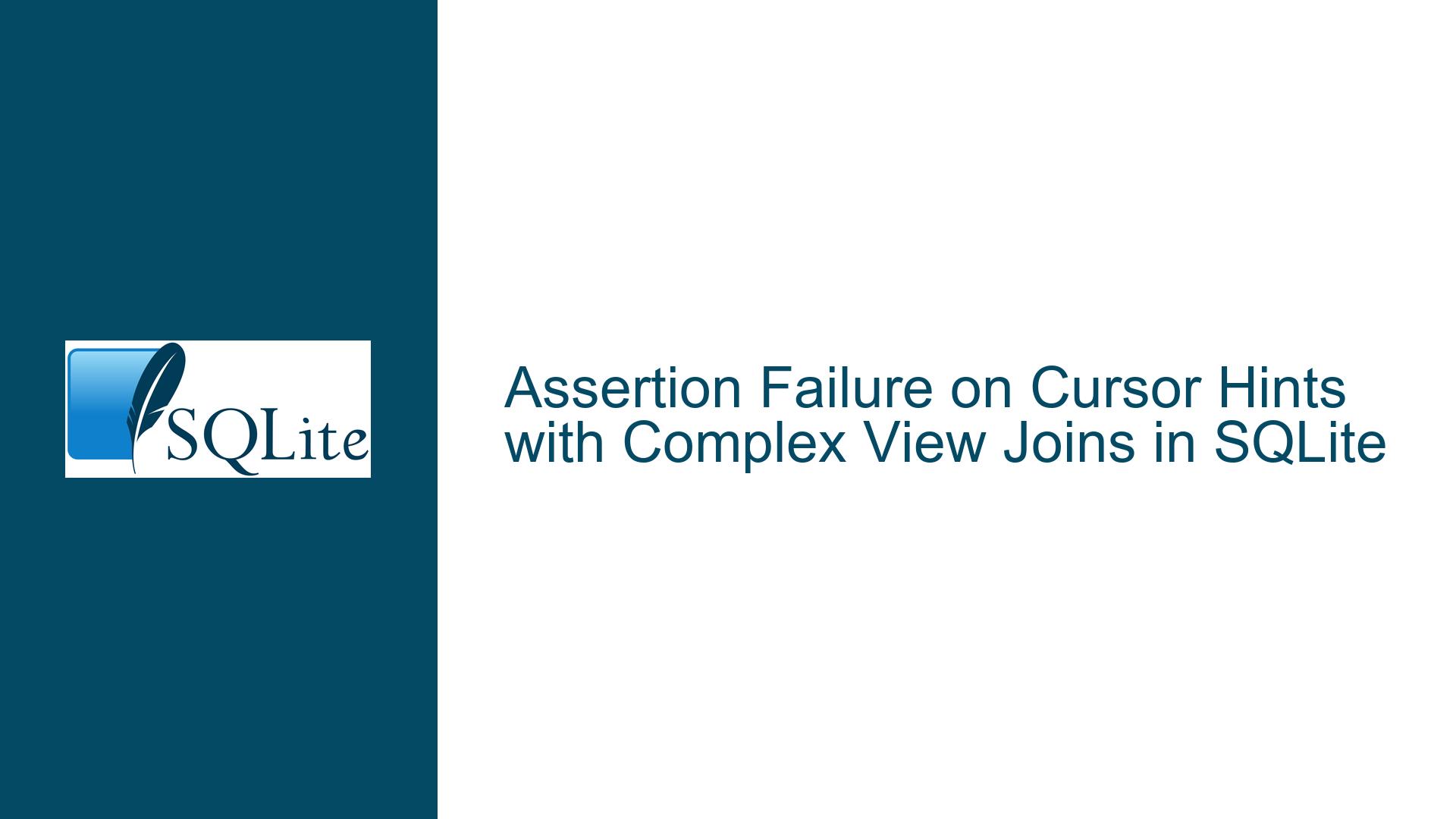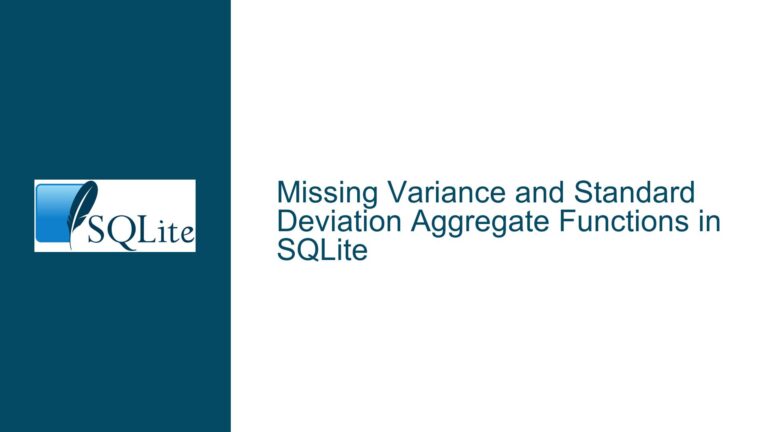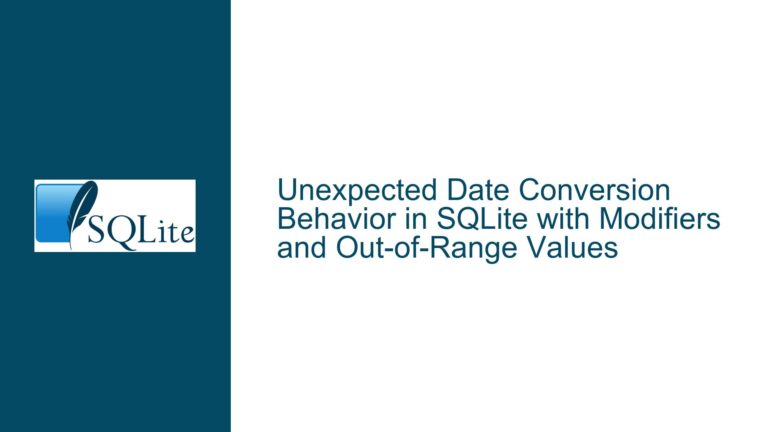Assertion Failure on Cursor Hints with Complex View Joins in SQLite
Root Cause Analysis: Cursor Hint Mismatch During Query Optimization
The core issue arises from an assertion failure triggered during the execution of a complex query involving multiple nested views and JOIN operations. The failure occurs specifically in the sqlite3VdbeExec function at the point where the Virtual Database Engine (VDBE) validates cursor hint opcodes. The assertion expects the opcode to be either OP_SeekGE or OP_SeekLE but encounters an unexpected value, indicating a mismatch between query planner optimizations and cursor hint generation.
This problem is tied to the interaction between SQLite’s query flattening optimizations (SQLITE_QueryFlattener) and cursor hint logic (SQLITE_ENABLE_CURSOR_HINTS). The assertion failure manifests when the query planner generates an execution plan that violates assumptions about index seek operations on WITHOUT ROWID tables. The failure is deterministic under specific conditions involving deeply nested views with RIGHT JOINs and self-referential JOIN patterns.
Key Contributing Factors: Query Flattening and Cursor Hint Generation
Query Flattening Optimization Conflicts
TheSQLITE_QueryFlatteneroptimization attempts to simplify nested SELECT statements by merging subqueries into the main query. In this scenario, the optimization transforms the complex view hierarchy (v2→v3→v4) into a flattened execution plan. However, this process incorrectly generates a cursor seek operation that bypasses the expected index traversal logic forWITHOUT ROWIDtables. The flattened query plan inadvertently creates a scenario where the cursor initialization expects a range search (OP_SeekGE/OP_SeekLE) but receives an incompatible opcode.View Expansion and Join Reordering
The nested views (v3andv4) create a combinatorial explosion of JOIN permutations. The RIGHT JOIN inv3forces a specific table access order that conflicts with the cursor hint system’s expectations. When combined with the self-joins inv4(FROM v3, v3), the query planner generates an execution plan that misaligns the cursor hint initialization sequence. This is exacerbated by the PRIMARY KEY constraint on theWITHOUT ROWIDtable, which modifies index storage behavior compared to standard rowid tables.Cursor Hint Validation Assumptions
TheSQLITE_ENABLE_CURSOR_HINTSfeature introduces runtime checks to verify that cursor operations adhere to index search boundaries. The assertionpOp->opcode==OP_SeekGE || pOp->opcode==OP_SeekLEassumes that all index seeks onWITHOUT ROWIDtables will use these opcodes when cursor hints are active. However, the query flattening process creates a scenario where the initial seek operation is optimized out or replaced with a different opcode, violating this assumption.
Resolution Strategy: Patching, Workarounds, and Query Restructuring
1. Apply Official SQLite Patch
The definitive fix is implemented in SQLite check-in 221fdcec964f8317, which addresses the cursor hint validation logic during query flattening. Apply this patch to your SQLite build if using a version between 3.41.0 and the patched release. For systems using the amalgamation source:
# Download patched amalgamation
wget https://sqlite.org/src/raw/221fdcec964f8317?name=sqlite3.c -O sqlite3.c
wget https://sqlite.org/src/raw/221fdcec964f8317?name=sqlite3.h -O sqlite3.h
Recompile with your existing build flags to retain debugging capabilities.
2. Disable Query Flattening Optimization
As a temporary workaround, disable the SQLITE_QueryFlattener optimization using PRAGMA statements or compile-time flags:
-- Runtime disable (per-connection)
.testctrl optimizations 0x00000001; -- SQLITE_QueryFlattener = 0x00000001
For persistent configurations, recompile SQLite with:
-DSQLITE_OMIT_QUERY_FLATTENER=1
Tradeoff: Disabling query flattening may increase query execution time for complex views due to loss of optimization benefits. Monitor performance impacts.
3. Query Restructuring to Avoid Optimization Conflicts
Modify the view definitions to reduce JOIN complexity and prevent the query planner from generating invalid cursor operations:
Original Problematic Views:
CREATE VIEW v3 AS SELECT 0 FROM v2 JOIN (v2 RIGHT JOIN v1);
Restructured Views:
-- Break nested RIGHT JOIN into explicit subqueries
CREATE VIEW v3 AS
SELECT 0 FROM v1
LEFT JOIN (SELECT 0 FROM v2) AS sub ON 1=1;
This restructuring forces the query planner to handle JOIN ordering differently, avoiding the optimization path that triggers the cursor hint assertion failure.
4. Debugging with EXPLAIN and VDBE Tracing
For custom query analysis, use SQLite’s diagnostic tools to inspect the generated opcodes:
EXPLAIN
SELECT * FROM v3 JOIN v3 AS a0, v4 AS a1, v4 AS a2, v3 AS a3, v3 AS a4, v4 AS a5
ORDER BY 1;
Combine with compiler flags -DSQLITE_ENABLE_TREETRACE and -DSQLITE_ENABLE_WHERETRACE to log optimization phases:
export SQLITE_ENABLE_TREETRACE=1
export SQLITE_ENABLE_WHERETRACE=1
./sqlite3 <query.db> 2> trace.log
Analyze trace.log for WHERE clause processing and tree transformations that precede the assertion failure.
5. Index Strategy Adjustments for WITHOUT ROWID Tables
Modify the table schema to influence index selection patterns:
-- Original
CREATE TABLE v1 (c1, PRIMARY KEY(c1)) WITHOUT ROWID;
-- Modified
CREATE TABLE v1 (c1 TEXT COLLATE BINARY, PRIMARY KEY(c1)) WITHOUT ROWID;
Adding explicit collations or data types can alter the query planner’s choice of index traversal methods, potentially avoiding the problematic cursor hint sequence.
6. Cursor Hint System Overrides
For advanced users with access to SQLite internals, implement custom cursor hint validation logic in vdbe.c:
// Original assertion
assert( pOp->opcode==OP_SeekGE || pOp->opcode==OP_SeekLE );
// Modified conditional handling
if( pOp->opcode!=OP_SeekGE && pOp->opcode!=OP_SeekLE ){
sqlite3_log(SQLITE_WARNING, "Invalid cursor hint opcode: %d", pOp->opcode);
// Fallback to full table scan
pOp->opcode = OP_Noop;
}
Caution: This requires deep understanding of VDBE opcodes and should only be used as a last resort.
7. Version-Specific Workarounds
If unable to apply the official patch, implement a runtime check for the problematic SQLite version:
#!/bin/bash
SQLITE_VERSION=$(sqlite3 --version | awk '{print $1}')
if [[ "$SQLITE_VERSION" =~ ^3\.41\.0 ]]; then
echo "Applying query flattening workaround..."
sqlite3 "$1" ".testctrl optimizations 0x00000001"
fi
Automatically disable SQLITE_QueryFlattener when detecting vulnerable versions.
Long-Term Prevention: Testing and Monitoring Strategies
Regression Test Suite Enhancement
Incorporate queries with deep view nesting andRIGHT JOINpatterns into automated testing frameworks. Use the provided test case as a template for validating cursor hint behavior.Query Complexity Analysis
Implement query complexity metrics (JOIN depth, view expansion count) to flag high-risk queries during development. Reject or rewrite queries exceeding thresholds like:- More than 5 nested view layers
- Self-joins on the same view ≥3 times
- RIGHT JOIN combined with WITHOUT ROWID tables
Optimization Flag Auditing
Maintain an inventory of enabled SQLITE_ENABLE_* flags across deployments. Validate that combinations likeSQLITE_ENABLE_CURSOR_HINTS+SQLITE_QueryFlattenerare tested under load with complex schemas.Cursor Hint Instrumentation
Extend SQLite’s debugging facilities to log cursor hint operations:
#ifdef SQLITE_DEBUG
if( pOp->opcode==OP_SeekGE || pOp->opcode==OP_SeekLE ){
printf("Cursor hint at %d: opcode=%d, index=%s\n",
pc, pOp->opcode, pOp->p4.pIdx->zName);
}
#endif
Cross-reference these logs with query plans to detect opcode mismatches early.
By systematically addressing the cursor hint validation flaw through patching, query restructuring, and enhanced monitoring, developers can mitigate this specific assertion failure while hardening their SQLite deployments against similar optimization edge cases.






